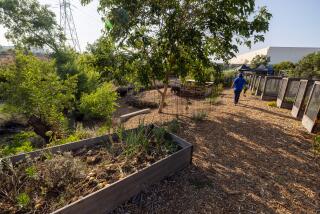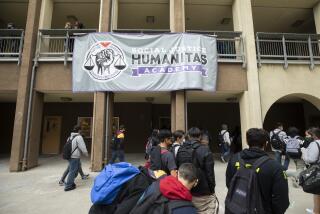It’s Standard Time Again in California
- Share via
The state commission asked to determine what California’s public school students should learn at various grade levels has unveiled drafts of its standards in two more subject areas: science and history-social science.
The proposed science standards emphasize fundamental knowledge as well as the use of the scientific method. And they treat high school chemistry and physical science as separate disciplines--rather than integrating the two, as is becoming increasingly common in many schools.
High schoolers, according to the panel, should know that viruses contain DNA or RNA and must use a cell’s chemical machinery to spread.
The history-social science standards incorporate topics from civics, geography and economic reasoning, beginning in the early grades.
Rather than expecting teachers to rely only on textbooks, the standards emphasize the use of biographies of people such as Jefferson Davis and Ulysses S. Grant as a way to understand the Civil War. They also expect students to become familiar with speeches, such as the Gettysburg Address, to enliven the topic.
Though released only this week, the draft science standards already have stirred considerable debate.
The Academic Standards Commission got off to a false start in writing them in November when it rejected the offer of a group led by Nobel Prize-winning scientists to do the work for free, awarding a contract to a competing panel. The two groups squabbled in public over their differing approaches--with the Nobelists emphasizing traditional scientific knowledge and the other coalition, which included more educators, placing more importance on making science fun and accessible for a wide range of students.
In the wake of that controversy, representatives of both groups were asked to work together, and Nobel Prize-winning chemist Glenn Seaborg was appointed to the standards commission to chair its science committee.
In writing its drafts, the commission conducted focus group sessions with parents, teachers, and business and community leaders. It also relied on experts, as well as academic standards now used in other states, such as Virginia, Texas and Florida. The science standards also reflect documents that shape instruction in Britain, France, Japan and Switzerland.
“Students and teachers deserve to know precisely what they are accountable for: mastery of fundamental content equal to or better than that to which students around the world have been consistently exposed,” Seaborg said. “To do anything less would be irresponsible.”
After public hearings, the learning guidelines will be revised by the Academic Standards Commission and submitted by Aug. 1 for approval to the State Board of Education, which will take its own crack at them.
Even then, the standards are but a step toward the eventual goal of creating a new state test that will cover these subjects--as well as math and language arts--in grades five, eight and 10. The commission finished its work in math and language arts last fall.
Following are excerpts. The complete draft standards can be viewed on the commission’s Web site: www.ca.gov/goldstandards
HISTORY, SOCIAL SCIENCE
Grade 5
Students analyze the important ideas that influenced the foundation of the American republic. Therefore, students:
1. Explain the idea that the Constitution both empowers and limits central government, and describe the relationship between limited government and individual rights.
2. Assess the significance of the new Constitution of 1787, including the struggles over its ratification and the reasons for the addition of a Bill of Rights.
3. Identify the powers granted to the Congress, the president and the Supreme Court, and those reserved to the states.
4. Explain the meaning of the American creed that calls on citizens to safeguard the liberty of individual Americans within a unified nation; to respect the rule of law; to contribute to the welfare of their communities and the nation; to preserve the Constitution.
5. Describe the fundamental principles of American democracy, including that the people are sovereign, that individual rights are protected within majority rule, equality of rights, patriotism, personal responsibility and religious liberty.
Grade 8
Students analyze the multiple causes, key events and complex consequences of the Civil War. Therefore, students:
1. Compare and contrast the economic and political differences between the North and South, as exemplified by statesmen such as Daniel Webster and John C. Calhoun.
2. Describe the geographical differences between the two regions and the differences between agrarians and industrialists.
3. Explain the significance of the Wilmot Proviso, the Compromise of 1850, the Kansas-Nebraska Act, the Ostend Manifesto, States Rights Doctrine, the Dred Scott case and the Lincoln-Douglas debates.
4. Analyze Abraham Lincoln’s presidency and its significant writings and speeches such as his speech at the Cooper Union, the Gettysburg Address, the Emancipation Proclamation, his inaugural addresses (and their relationship to the Declaration of Independence).
5. Describe the constitutional issues posed by the doctrine of nullification and secession.
6. Draw from biographies to describe the views and lives of leaders on both sides of the war, including Ulysses S. Grant, Jefferson Davis, Robert E. Lee.
7. Explain critical developments in the war, including major battles, geographical advantages and obstacles, technological advances, the human costs and Lee’s surrender at Appomattox.
8. Explain how the war affected civilians and combatants, with the largest death toll of any war in American history, and explain the physical devastation.
Grade 10
Students analyze patterns of global change in the era of Western nationalism and imperialism, in at least two of the following areas: Africa, Southeast Asia, China, India, Latin America and the Philippines. Therefore, students:
1. Trace the rise of industrial economies and describe their link to European imperialism and colonialism.
2. Analyze how different points of view and self-interest play a role in conflict over territory and resources (the causes of and desire for hegemony; the ways in which national security and economic interests are perceived; the relationship between domestic affairs and foreign policy).
3. Map the colonial rule of such nations as England, France, Germany, Italy, Japan, the Netherlands and the United States.
4. Evaluate imperialism from the perspective of the colonizers and colonized and the immediate and long-term responses by the colonized peoples.
5. Analyze the independence struggles of the colonized regions of the world, including the leaders of the movement.
SCIENCE
Grade 5
Earth Science: Geologic Features
1. Students classify rocks and minerals by their properties, and know the processes by which rocks form.
Students identify and distinguish igneous and sedimentary rocks by their properties, and describe some ways in which they form.
Students identify common rock-forming minerals (including quartz, calcite, feldspar, mica and hornblende) and ore minerals using a table of diagnostic properties.
2. Students identify the patterns of earthquake occurrence.
Students know earthquakes are sudden motions along breaks in the crust called faults.
Students know earthquakes often come in groups. They know how to prepare for an earthquake and how to behave during and after earthquakes.
Students know that earthquakes and volcanoes occur in distinct distribution patterns on the Earth.
Grades 6-8
Physical Science: Chemical Reactions
Students know that atoms can combine to make molecules, and that chemical reactions are processes in which atoms and molecules are rearranged into different combinations.
1. Students know that elements are collections of identical atoms, that compounds are collections of identical molecules and mixtures are collections of different atoms and molecules.
2. Students know that a compound is formed by a chemical combination of two or more elements and that compounds have properties different from those of their constituent atoms.
3. Students know that chemical reactions produce new substances called products, with properties that are different from those of the reactants.
4. Students know that chemical reactions can evolve or absorb heat.
5. Students know that a molecular formula denotes the numbers and kinds of atoms in a molecule and know the names and formulas of simple compounds (H2O, CO2, HCl, NaOH, NaCl).
6. Students know that in chemical reaction equations the numbers of each kind of atom remain unchanged, and in chemical reactions the mass of the products is the same as the mass of the reactants.
7. Students know that the groups of the Periodic Table organize elements by chemical properties.
Grades 9-12
Life Science: Cell Biology
1. Students compare and contrast the cellular structures of prokaryotic and eukaryotic cells.
2. Students analyze photosynthesis and cell respiration in terms of the cellular structures in which they occur, energy flow and chemical compounds involved (such as carbon dioxide, oxygen, glucose, water, ATP and NADH).
3. Students know that enzymes are proteins that serve as catalysts to increase the rate of biochemical reactions (by lowering activation energy) without altering the reaction equilibrium.
4. Students know that viruses contain DNA or RNA genomes and must use the biochemical machinery of a cell in order to be propagated.
(BEGIN TEXT OF INFOBOX / INFOGRAPHIC)
Academic Standards Commission Schedules Public Hearings
April 28
4 to 7 p.m.
San Diego County office of education*
Joe Rindone Technology Center and three video conferencing sites
6401 Linda Vista Road
San Diego
(619) 292-3719
April 29
4 to 7 p.m.
Riverside County office of education**
Education Conference Center
3939 13th St.
Riverside
(909) 369-6304
April 30
3 to 6 p.m.
Eureka City Hall Building
531 K Street
Eureka
(707) 445-7030
May 1
2 to 5 p.m.
Pleasanton United School District boardroom
4665 Bernal Ave.
Pleasanton
(510) 426-4330
* Satellite hookup at Encinitas Union district office, Escondido Union elementary district office, Grossmont Union High School district office and the Orange County office of education.
** San Bernardino County office of education will also participate.
More to Read
Sign up for Essential California
The most important California stories and recommendations in your inbox every morning.
You may occasionally receive promotional content from the Los Angeles Times.










